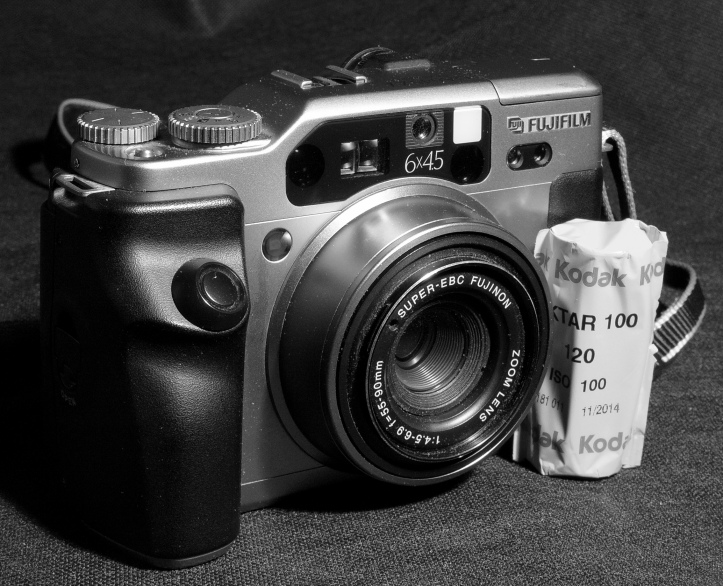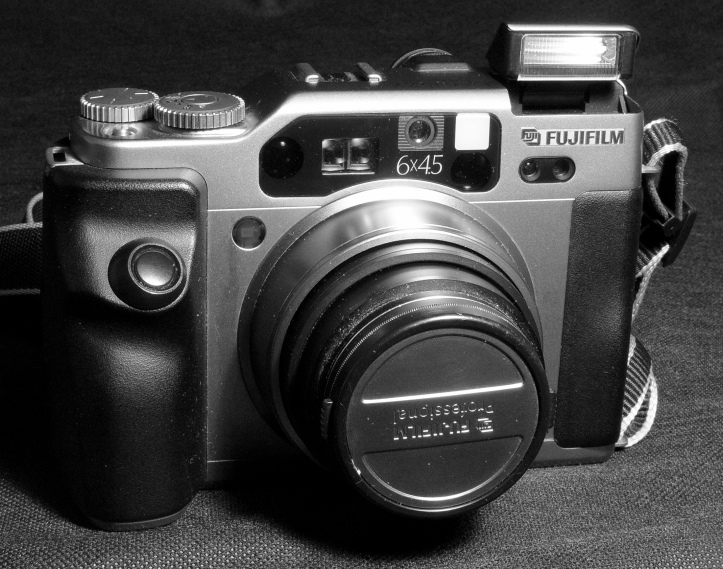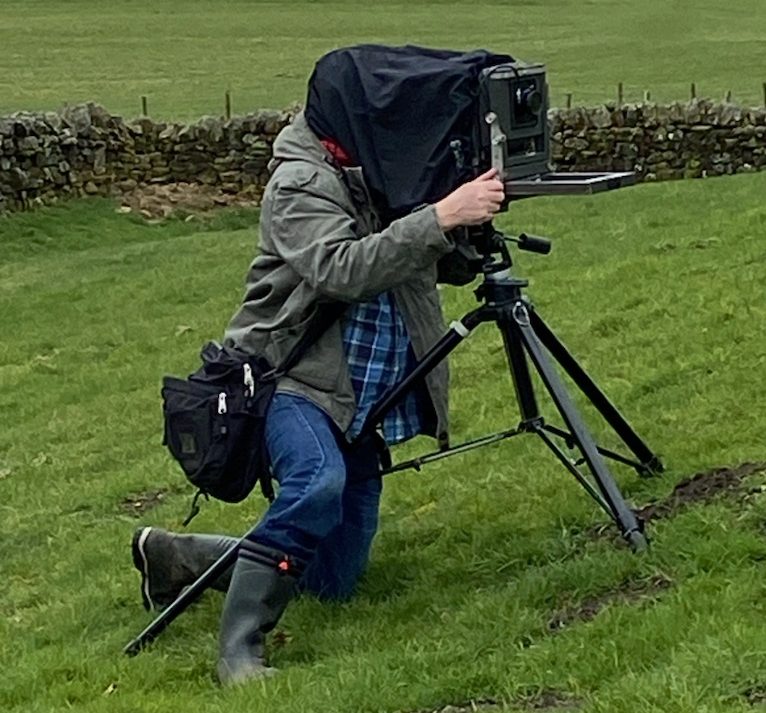Christmas 2014 made me the pleased recipient of a Fujilm GA645Zi. Thanks Santa; it’s amazing how you always know just what I want !

Now that I’ve had the chance to run a few films through, it’s time to pass on my thoughts about the camera. To put this into context, I should state where this camera fits into the kevinphotographer ecosystem.
This isn’t my first or only medium format camera. I have enough parts of the Mamiya RZ67 to make up two RZ’s at the same time (not that I have any reason to); a Yashicamat 124G; a Holga 120WPC pinhole; and a few vintage folders.
The RZ remains my “main” camera, particularly for landscape photography; but I wanted something more informal, for use as a travel/family holiday camera, which would replace the use of 35mm film or digital cameras for those occasions.

The Fujifilm GA645Zi is a pretty unusual camera. It has some features which are not typical of medium format cameras:
- Semi-automated film loading
- Automatic film winding
- Built-in flash
- Automatic aperture-priority exposure, with shutter speed and aperture displayed in the viewfinder
- Imprinting of exposure details and date on the negative, thankfully well outside the image area.
The camera handles very well and I find it easy to use. By default, it’s auto-everything, but exposure compensation and manual exposure are both available if I want to take more control.

Manual exposure control is not as intuitive as older film cameras, since it requires turning the rear dial once to change aperture, then press in the +/- button in front and turn the dial again to change shutter speed. The selected aperture and shutter speed are displayed on the rear LCD screen, which isn’t as easy as reading them off a shutter speed dial and the lens collar. But, it’s no worse than many 35mm film cameras from the 1980s onwards, or the vast majority of digital cameras.

Manual focus is the weakest part of the control set. You have to press in the AF/M button on the rear, then turn the control dial; the selected focus distance is displayed on the LCD screen (in either feet or metres) and in the viewfinder (in metres only). This is really just zone focussing, as there are no focus aids in the viewfinder; the camera is neither a rangefinder nor an SLR.
Since the film size is smaller than my Yashicamat 6*6 TLR, it’s surprising that the camera is not really smaller than the Yashicamat. The base is wide than the Yashicamat is tall.

The dimensions of the Fuji are 161.5mm wide * 108.5mm high and 73mm deep.
The Fuji isn’t as deep as the Yashicamat, and this does make some difference when packing in some bags. I find it easier to fit the Fuji into a work bag alongside an iPad, whereas the Yash is just a bit too “boxy” to carry that way. Both cameras are easy to sling over the shoulder and their weight seems negligible when carried.

The biggest advantage that the Fuji has over the Yash, for my purpose, is that the lens is 35mm-equivalent compared to the Yashicamat’s 50mm-equivalent “normal” lens. I’ve always thought that if I can only carry one lens, then 35mm equivalent would be my choice.
But wait, I hear you say, I can see the word “zoom” printed on the front of the camera ! That’s right, it does have a zoom lens, albeit with the narrowest zoom range imaginable. The 35mm equivalent focal length is 34-56mm. The focal length is not continously vairiable, but has four fixed positions.
In practice, for my purposes, the zoom is handy. I start off with the wide setting and zoom to the longest setting when necessary; treating it like have two lenses, roughly 35mm and 50mmm, not bothering with the settings in between, and able to switch between those settings in a second. About 90% of the time I use the widest setting. I hardly ever use lenses longer than “standard” so I’m not worried about missing a longer setting. A 28mm equivalent setting would be nice, but would presumably add to the bulk of the camera.
The maximum aperture of the lens attracts some comment from other reviewers. At the widest setting, it is f4.5, and this narrows to f6.9 at the longest setting.
So, clearly the maximum aperture presents some challenges for low-light shooting. But there are a couple of factors which mean it’s not quite such a problem as you may think:
a) The absence of a mirror means that there’s no mirror vibration so your slowest hand-holdable shutter speed will be slower than it would be with an SLR. I’ve taken a few images at 1/15s and 1/8 might be possible.
b) Whilst I have tended to avoid ISO400 or faster films in 35mm, with medium format and selected films there is much less need to worry about using ISO400, and push-processing if necessary. In colour, Kodak Portra 400 will provide excellent results. For mono I’ve been using Kodak Tri-X, including pushing one film to EI 1600 with good results – see the example below.

Slower maximum apertures are common in medium format; the Yashica has a widest aperture of f3.5. I know that the Mamiya 645 lenses include an 80mm f1.9 model, but I’m not really in the market for a system-type 645 camera; my Mamiya RZ67 provides that function and contrasts with the Fuji which trades in the lack of exchangeable film back, interchangeable lenses, and interchangeable finders, for light weight and relative compactness.
On a trip to Leeds, I started with a roll of Tri-X 400 rated at EI1600, which had a few frames to finish off. They didn’t need to shot at 1600 because there is plenty of light in the Corn Exchange due to a glass roof, but to me the image quality is quite good and doesn’t scream out “High ISO” or “push processed” – so I won’t worry too much about rating Tri-X at 1600 even if some shots could be taken at a lower ISO.The film was processed with Kodak TMax Developer at 24C in a Jobo CPE2 processor, using the times recommended in the Kodak technical publication.

The next set is with some 220-format Kodak Tri-X 320 (TXP) film. As it expired in 1996 I shot the film at EI 200 to allow two-thirds of a stop extra exposure, based on the rule of thumb of one stop for every ten years after expiry.
Click on any image for a larger view.
Next I walked up the Kirkgate Markets and continued with the Tri-X 320:
Here are more Tri-X at 1600 images, from the Grainger Market and Laing Art Gallery in Newcastle.




Next, a few images from Gibside, a National Trust property, shot on Ilford XP2 Super and developed with the Jobo processor and Digibase C41 chemicals at 38C.
It was quite a dull day and I used my lightest tripod, which was strong enough to support the Fuji.
Finally, some Tri-X 400 shot at box speed and developed in D76 1+1, taken at Ryal in Northumberland.
Any images taken with this camera and posted to Flickr, after this post was made, can be seen at here
I hope these few words and images give you some idea of whether the Fujifilm GA645Zi might suit your needs.
































A very well done review.
LikeLike
I want one!
LikeLike
I’ve considered the Fuji GA range of cameras as a replacement for my camera phone or a 35mm camera, too! Now I really want one. 🙂
LikeLike
[…] on from my initial review of the Fujifilm GA645Zi, I continue to be delighted by the camera. One of the things which strikes me when I take a film […]
LikeLike
Thank you for a well thought out review. I purchased mine 2 years ago but I remember when it was first introduced by Fujifilm’s marketing as the perfect wedding pro camera. The 645 format makes a perfect 8×10, vertical without turning the camera, so many features, auto focus, zoom lens, 120/220 auto exposure. As a wedding photographer during that time I was drooling over its capable features. You know it can still shoot a wedding today.
LikeLike
What a great review – and I really appreciate you have tried the multiple film types and provided information to go with them.
LikeLike
Hi Kevin, good review and excellent images, I’ve just been looking through many of your articles and different images,”gob-smacked” brilliant stuff, I’m sure we must have crossed paths at some point as most of your locations are the same as mine living locally in Walkergate I get out and about quite regularly up and down coast and to all other places you’ve been with the exception of Scotland not as much. I’ve been shooting film for a while now off and on with digital and it’s getting to the point that when I shoot digital I nearly always post process with the idea of film in mind, so I might as well shoot film.
Keep up the good work….cheers Mick.
LikeLike
Thanks for your kind comments Mick, and it’s nice to hear from a local fellow film user. I’ve just enjoyed looking at your site, particularly the images from Earsdon cemetery.
LikeLike
OK you’ve corrupted me…..I am a Mamiya fanatic, however, I can see this would be a better choice for medium format street photography. I am watching several on EBAY….seems like I’m going to ‘gift myself’ one for Christmas.
LikeLike
I know what it’s like being a Mamiya fanatic … I’ve just bought a Mamiya ZM 35mm SLR, to be put away for Christmas, even though I keep trying to tell myself that I don’t use 35mm any more.
LikeLike
Just thought I would update my comment. I did get a GA645Zi, and also found that it worked well for Architecture and the urban environment in general. I also wrote an Article about my two FujiFilm Cameras here:
https://emulsive.org/reviews/camera-reviews/fuji-camera-reviews/a-look-at-two-uniquely-different-medium-format-fujifilm-cameras-the-fuji-ga645zi-professional-and-fuji-gw690iii-professional
LikeLike
The Fuji Zi was my favorite travel camera, using mostly Fuji Velvia 220 ore Astia 220 film (32 exposures a rol) ore Portra 220 for negatives. Today I use the digital 50R but I’m hoping they will make a the same concept as the Fuji Zi with a zoom and 100/400MP the new GFX 100S is a step to it.
LikeLike